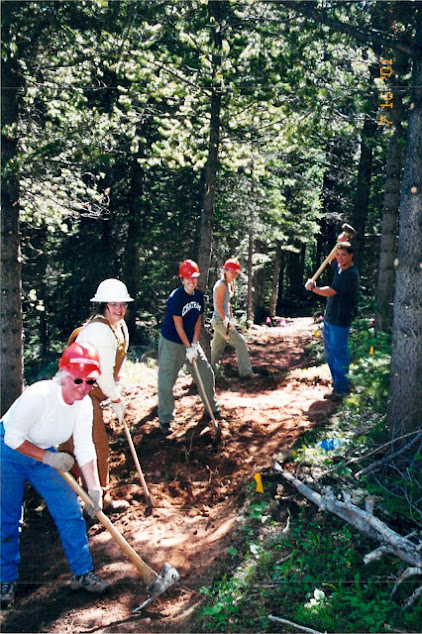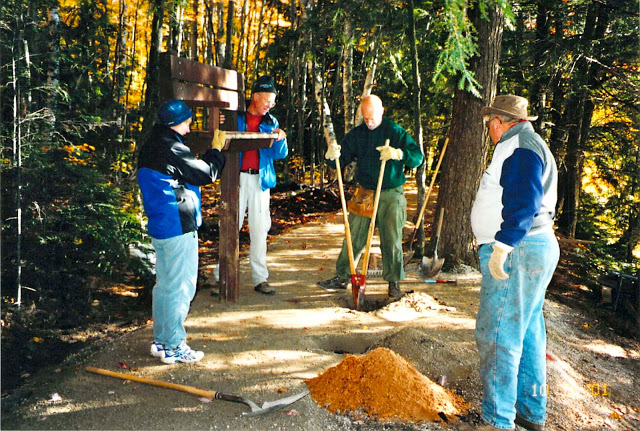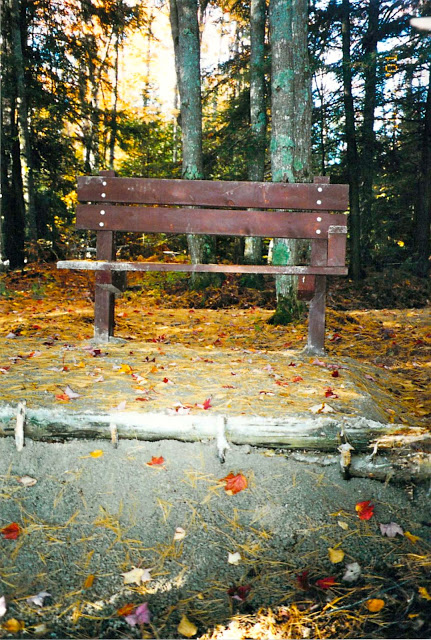The only whitewater available in Chicago is when a storm is pushing huge waves onto Chicago’s beaches. So in 1982, when our family vacation included a visit to Yellowstone and Grand Teton National Parks, we investigated the possibility of whitewater rafting when we were in Jackson, Wyoming. We went into the rafting company office to inquire about rates and availability, but were told that our youngest, Steve, then age five, was too young for the trip. He needed to be seven. There was nowhere to leave him if we went rafting, so we turned around and began to leave when the clerk told us to hang on a minute. After a brief consultation with someone else in the office, she told us Steve could go on the trip, but we'd have to keep him sitting on the bottom of the raft and hold onto him. We agreed! You can see him in the center of the raft.
The first Pacuare River photo below shows me front right with Ellen in the middle (pink helmet) and Len and Marlene in the back. It was their first whitewater experience. Much of the area we were rafting was one of Costa Rica’s rain forests and the scenery was magnificent, and when we weren’t paddling for our lives we were able to enjoy the views.
In the next photo, the guide had lost control as we hit a wave train, and our raft bent in the middle as we mounted a boulder which catapulted me out. I grabbed the rope that circles the top of the raft (called the chicken rope) as I went over the side and hung on and quickly pulled myself back in, with the others helping me. One nice thing about Costa Rican rivers — the water is nice and warm, not cold from snow-melt like the rivers in Alaska and Colorado! This was the only whitewater adventure where I ever went for an unplanned swim. On all these raft trips, the guides allow us to swim in the lulls between rapids, and in the warmer river waters, everyone goes swimming. That also gives everyone practice getting back in the raft in case you get thrown out. Again, we are all wearing helmets which testifies to the ferocity of the river. A video of this trip is here.
Multi-day excursions allow the participants and guides to get to know each other much better, and the days on the water seem to be more relaxed and carefree than on single day trips. Water fights often develop between boats as part of the fun. A video of this trip is available here.
In 2006 and again in 2008 I canoed 120 miles down Utah’s Green River through Canyonlands National Park with Greg’s adventure company. The stark high mountain desert scenery and colorful rock formations entranced me, and exploring the ancient Anasazi Indian cliff dwellings provided an amazing history lesson. There was no dangerous whitewater on the trip or we would have had to use rafts, not canoes. Since all our boats were heavily loaded with food, water, and all the gear required for a dozen people on an eight day expedition, the tricky riffles and class I rapids we hit had to be cautiously negotiated to prevent capsizing and losing or damaging needed gear and food.
Below you see our four rafts loaded with all our food, camping gear, water, and tools for the work project.
The professional rafting company, O.A.R.S. provided the rafts and the licensed, experienced guides, and we didn’t even have to paddle which allowed me to take movies of the rapids and some photos like that below in one of the many rapids. That standing wave is about eight feet tall. The video can be found at YouTube.com/cmorhiker.
As you have probably figured out, in order to safely negotiate rapids in a paddle raft, the licensed, trained guide has to steer the raft to the proper, safe routes through the rapids, and it is the job of the paddlers to provide constant forward momentum so the guide is able to steer us. If there is no forward momentum, the raft will simply go where the current takes it which is NOT the safest route. That’s why I can’t take photos while we are in the best rapids while I’m paddling like mad to help the guide get us safely through.
Below are a few more photos. This is the Colorado River in Glenwood Canyon. I've seen the photographer set up on the bike trail that was built along I-70 through the canyon as I've biked there, and I always wanted to do the raft trip, and finally I did! I'm on the left side of the raft with my green hat.
The next photo is one I took from my raft just after we had survived this waterfall on West Virginia's New River National Gorge...
In 2009 I again rafted Wyoming's Snake River with Dave Hansen Whitewater and here we are at Big Kahuna rapid again, and I have my usual green Tilley hat. The photographer got two shots this time -- the first as we hit the rapid and the second as it completely inundated our raft! Fun!
My last trip to share is the grand-daddy of all raft trips — seven days in 1999 down the 277 miles of the Colorado River through the Grand Canyon, negotiating 166 rapids in a motorized pontoon boat that was about 40 feet long and hinged in two places — articulated — to bend and absorb the worst that the rapids can dish out. The Grand Canyon does not use the class I to VI rating scale used on most American rivers. Instead, it uses a 10 scale, and 47 of the rapids are rated five or above which means “high flip/swim potential.” The best way to experience the Grand Canyon is a two or three week trip in a paddle or oar raft, but that length of trip is very expensive, so we opted for a less expensive seven day trip. We still rafted the entire canyon, but to do it that quickly means fewer stops to hike and explore and also means traveling on our Canyoneer's motorized raft as seen in the photo below as it negotiates Hermit Rapid.
We even had the opportunity to experience a rapid without a boat -- body surfing! Here I am with my feet up to bounce off any rocks. I am wearing two PFDs (portable floatation devices or life jackets), one on my butt and one worn the correct way. This was so much fun, I hiked the one-third of a mile up the Little Colorado River Canyon and surfed back down three times before we had to leave. The water from the Little Colorado is generally a remarkable robin's egg blue, but a rain storm up canyon had brought all this red sediment down so even though it looks like I'm in mud, it's just discolored water.
Rafting the Grand Canyon in one of these large boats is safer because these large craft rarely flip! I used a disposable waterproof camera so the photos are not very good, but you get a feel for the wall of water that engulfed us in the shots below. The first is Separation Rapid just as the wall of water hit the raft...
...and Hermit Falls Rapid as the water engulfs half the raft...
... and Lava Falls Rapid, one of the largest in the Grand Canyon, as the water reaches my camera.
It was an awesome trip — the scenery, the solitude while a mile deep in the Grand Canyon, wonderful hikes up side canyons, a professional crew of three who did all the cooking, sleeping under the stars each night on sand beaches, and thrilling rapids that got our hearts pounding and kept us wet and cooled off. Bottom line: If you ever have a chance to do any whitewater rafting, I recommend you try it. I think you’ll like it!

























































